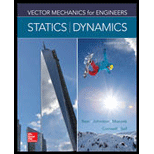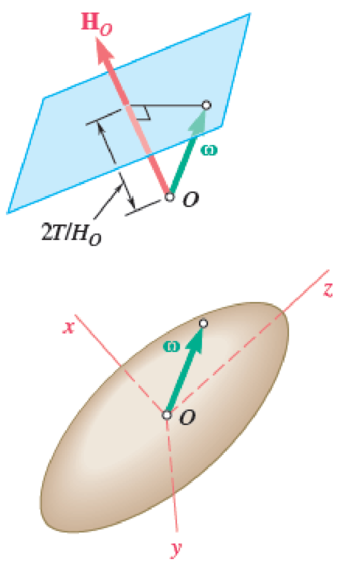
Concept explainers
Consider a rigid body of arbitrary shape that is attached at its mass center O and subjected to no force other than its weight and the reaction of the support at O.
(a) Prove that the angular momentum HO of the body about the fixed point O is constant in magnitude and direction, that the kinetic energy T of the body is constant, and that the projection along HO of the angular velocity ω of the body is constant.
(b) Show that the tip of the
(c) Show that with respect to a frame of reference attached to the body and coinciding with its principal axes of inertia, the tip of the vector ω appears to describe a curve on an ellipsoid of equation
The ellipsoid (called the Poinsot ellipsoid) is rigidly attached to the body and is of the same shape as the ellipsoid of inertia, but of a different size.

Fig. P18.143
Want to see the full answer?
Check out a sample textbook solution
Chapter 18 Solutions
Vector Mechanics for Engineers: Statics and Dynamics
- A homogeneous disk of weight W= 6 lb rotates at the constant rate @₁-17.8 rad/s with respect to arm ABC, which is welded to a shaft DCE rotating at the constant rate @2= 8.9 rad/s. Determine the angular momentum HA of the disk about its center A. resin. A 9 in The angular momentum HA of the disk about its center A is HA ( lb-ft-s)i + ([ lb-ft-sjarrow_forwardA rotating shaft carries four unbalanced masses 20 kg, 16 kg, 18 kg and 14 kg at radii 55 mm, 65 mm, 75 mm and 65 mm respectively. The 2nd, 3rd and 4th masses revolve in planes 80 mm, 160 mm and 280 mm respectively measured from the plane of the first mass and are angularly located at 65°, 135° and 270° respectively measured clockwise from the first mass.The shaft is dynamically balanced by two masses, both located at 55 mm radii and revolving in planes mid-way between those of 1st and 2nd masses and midway between those of 3rd and 4th masses. Determine, balancing mass by drawing couple polygon and their respective angular position graphically.arrow_forward4. (20 pts) A concrete block is lifted by a hoisting mechanism in which the cables are securely wrapped around their respective drums. The drums are fastened together and rotate as a single unit at their center of mass O. Combined mass of drum is 150 kg, and radius of gyration at O is 450 mm. A constant tension of 1.8 kN is maintained in the cable by the power unit at A. Determine the vertical acceleration of the block and the resultant force on the bearing at O. 600 mm 300 mm P = 1.8 kN m = 150 kg ko = 450 mm %3D 45° 300 kgarrow_forward
- The reciprocating masses of the first three cylinders of a four cylinder engine are 4.1, 6.2 and 7.4 tonnes respectively. The centre lines of the three cylinders are 5.2 m, 3.2 m and 1.2 m from the fourth cylinder. If the cranks for all the cylinders are equal, determine the reciprocating mass of the fourth cylinder and the angular position of the cranks such that the system is completely balanced for the primary force and couple. If the cranks are 0.8 m long, the connecting rods 3.8 m, and the speed of the engine 75 r.p.m. ; find the maximum unbalanced secondary force and the crank angle at which it occurs. solve graphicallyarrow_forwardProblem No. 5 A rotating shaft carries four masses A, B, C and D rigidly attached to it; the centers of mass are at 30 mm, 36 mm, 39 mm and 33 mm respectively from the axis of rotation. The masses are 7.5 kg, mB, 5 kg and 4 kg respectively. The axial distance between A and B is 0.4 m, that between B and C is 0.5 m and the axial distance between C and D is H meters. The eccentricities of A and C are at 90° to one another. If the shaft is to be balanced completely, find mB, H and the angular positions of the masses B and D.arrow_forwardQ2: The 5.5-kg lever OA with 250-mm radius of gyration about O is initially at rest in the vertical position (0 = 90°), where the attached spring of stiffness k = 100 N/m is unstretched. Calculate the constant moment M applied to the lever through its shaft at O which will give the lever an angular velocity w = 4 rad/s as the lever reaches the horizontal position = 0. Ans.: M = 2.95 N. CW k= 525 N/m 4 M 375 mm 200 mm 375 mmarrow_forward
- A 240-lb block is suspended from an inextensible cable which is wrapped around a drum of 1.25-ft radius rigidly attached to a flywheel. The drum and flywheel have a combined centroidal moment of intertia of 10.5 lb-ft-s^2. At the instant shown, the velocity of the block is 6 ft/s directed downward. The bearing at A as a frictional moment of 60 lb-ft. What is the kinetic energy of the system after the block moved after 4ft? (in ft-lb)arrow_forward(3) The 12-lb lever OA with 10-in. radius of gyration about point O is initially at rest in the vertical position (8 = 90°), where the attached spring of stiffness k= 3 lb/in is unstretched. Calculate the constant moment M applied to the lever at O which will give the lever an angular velocity o = 4 rad/sec as the lever rotates to the horizontal position at 0 = 0. k = 3 lb/in. wwww 15 15arrow_forwardThe rotor of a turbojet engine of an aircraft has a mass 180 kg and polar moment of intertia 10 kg.m2 about the rotor axis. The rotor rotates at a constant speed of 1100 rad/s in the clockwise direction when viewed from the front of the aircraft. The aircraft while flying at a speed of 800 km per hour takes a turn with a radius of 1.5 km to the left. The gyroscopic moment exerted by the rotor on the aircraft structure and the direction of motion of the nose when the aircraft turns, arearrow_forward
- A 1.6-kg tube AB can slide freely on rod DE which in turn can rotate freely in a horizontal plane. Initially the assembly is rotating with an angular velocity of magnitude w = 5 rad/s and the tube is held in position by a cord. The moment of inertia of the rod and bracket about the vertical axis of rotation is 0.30 kg.m2 and the centroidal moment of inertia of the tube about a vertical axis is 0.0025 kg.m2If the cord suddenly breaks, determine (a) the angular velocity of the assembly after the tube has moved to end E, (b) the energy lost during the plastic impact at E.arrow_forwardQ4. A particle, of mass 2 kg, is attached to one end of a light inextensible string. The other end is fixed to the point O. The particle is set into motion, so that it describes a horizontal circle of radius 0.6 metres, with the string at an angle of 30° to the vertical. The centre of the circle is vertically below O. (a) Show that the tension in the string is 22.6 N, correct to three significant figures. (b) Find the speed of the particle. 30° 0.6m Iarrow_forward3. The connecting rod of the steam engine shown schematically is assumed to be a slender uniform rod. 4 ft long weighing 322 Ib. the crank AO is 1ft long and rotates at a constant rate of 10 rad/s. the force on the 64.4 Ib cross-head at the given instant is 2142 Ib. neglecting friction. Determine the normal force on the crosshead and the horizontal and vertical components at crank pin force at A. А 45deg Вarrow_forward
 Elements Of ElectromagneticsMechanical EngineeringISBN:9780190698614Author:Sadiku, Matthew N. O.Publisher:Oxford University Press
Elements Of ElectromagneticsMechanical EngineeringISBN:9780190698614Author:Sadiku, Matthew N. O.Publisher:Oxford University Press Mechanics of Materials (10th Edition)Mechanical EngineeringISBN:9780134319650Author:Russell C. HibbelerPublisher:PEARSON
Mechanics of Materials (10th Edition)Mechanical EngineeringISBN:9780134319650Author:Russell C. HibbelerPublisher:PEARSON Thermodynamics: An Engineering ApproachMechanical EngineeringISBN:9781259822674Author:Yunus A. Cengel Dr., Michael A. BolesPublisher:McGraw-Hill Education
Thermodynamics: An Engineering ApproachMechanical EngineeringISBN:9781259822674Author:Yunus A. Cengel Dr., Michael A. BolesPublisher:McGraw-Hill Education Control Systems EngineeringMechanical EngineeringISBN:9781118170519Author:Norman S. NisePublisher:WILEY
Control Systems EngineeringMechanical EngineeringISBN:9781118170519Author:Norman S. NisePublisher:WILEY Mechanics of Materials (MindTap Course List)Mechanical EngineeringISBN:9781337093347Author:Barry J. Goodno, James M. GerePublisher:Cengage Learning
Mechanics of Materials (MindTap Course List)Mechanical EngineeringISBN:9781337093347Author:Barry J. Goodno, James M. GerePublisher:Cengage Learning Engineering Mechanics: StaticsMechanical EngineeringISBN:9781118807330Author:James L. Meriam, L. G. Kraige, J. N. BoltonPublisher:WILEY
Engineering Mechanics: StaticsMechanical EngineeringISBN:9781118807330Author:James L. Meriam, L. G. Kraige, J. N. BoltonPublisher:WILEY





